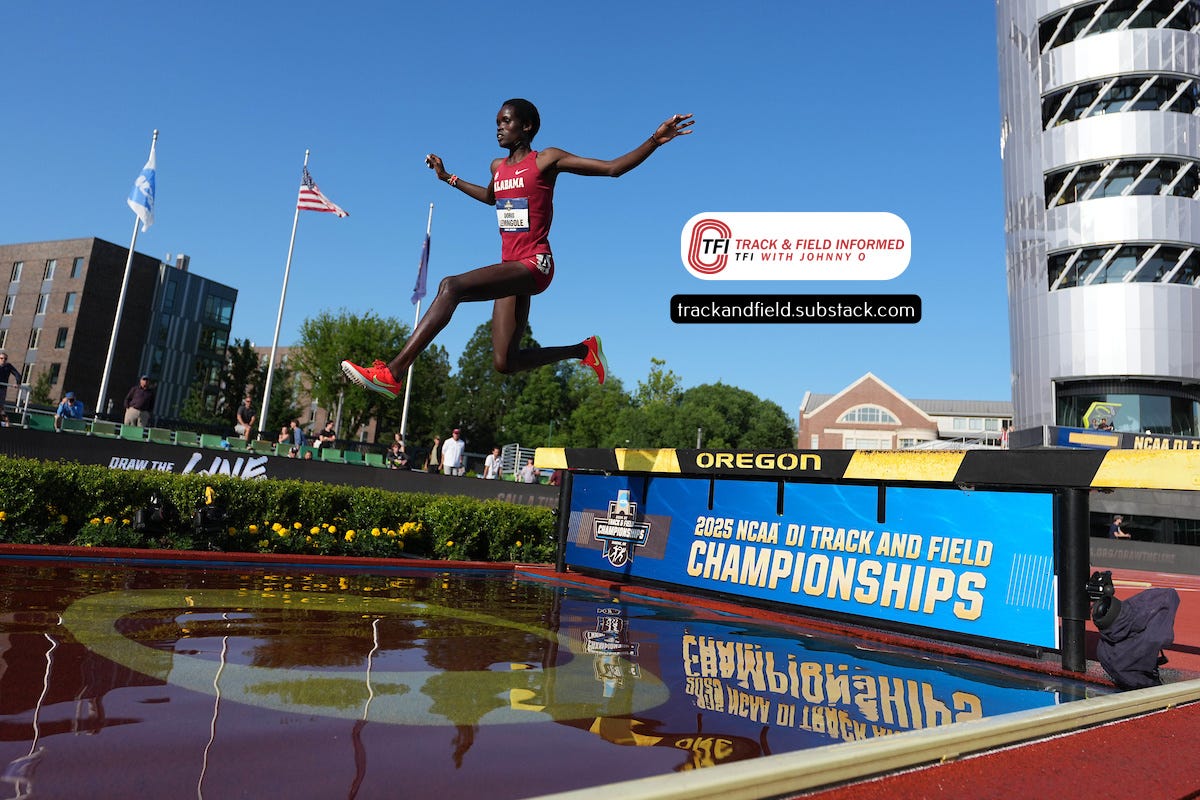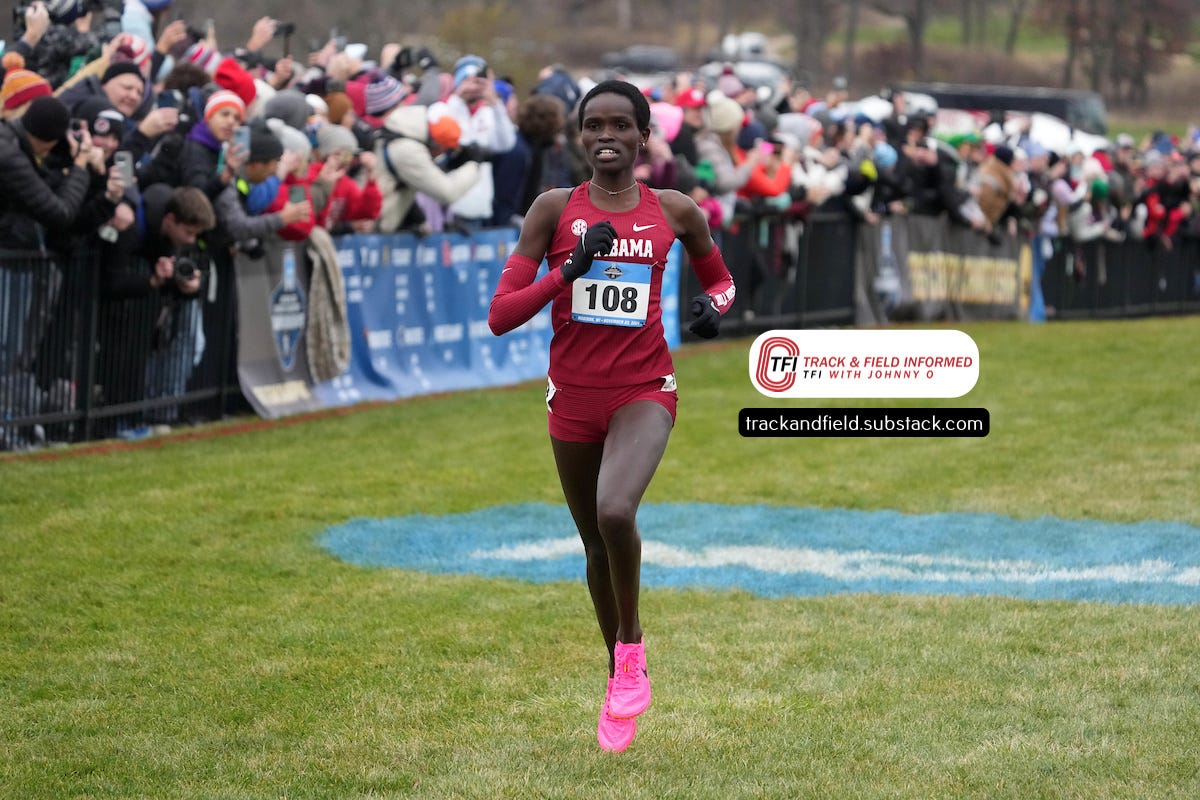Lemngole thrives on pushing the pace
University of Alabama sophomore broke nine minutes in steeplechase in wire-to-wire victory in NCAA Champs

Doris Lemngole of the University of Alabama does not like to run “slow”, even if she has been instructed to do so in order to conserve as much energy as possible when competing in a qualifying race of a championship meet.
Therefore, she wasn’t thrilled to have run at a modest pace — by her standards — while winning a semifinal of the women’s 3,000-meter steeplechase in 9:26.44 in the NCAA Track and Field Championships in Eugene, Oregon, on Thursday of last week.
Lemngole looked so relaxed and unpressed during the race that plenty of people figured she could smash her collegiate record of 9:10.13 when the final was held last Saturday.
Nonetheless, Nick Stenuf, the women’s distance coach at Alabama, said that following the semifinal Lemngole “looked at me dead in the eyes, and she goes, ‘In the final we race.’ ”
To which he replied, “Yes, we do. Go race girl.”
Lemngole, a sophomore from Kenya, did more than just race in the final.
She obliterated her collegiate record with an 8:58.15 clocking that was the fastest in the world this year at the time, made her the 14th woman to have run under 9 minutes in the event, and moved her to 11th on the all-time performer list.
“I didn’t believe myself,” the 23-year-old runner said to ESPN’s John Anderson when he asked her about breaking nine minutes. “I was so happy, because I’ve been aiming for this for so long. And yeah, here we come. I’m so happy.”
Stenuf, who describes Lemngole as extremely coachable, said he wasn’t shocked with her time. That “I knew we were close to nine minutes. I had told a lot of people she could crack it or come close to it. But the fact that she ran a 67 last lap, that’s what really impressed me.”
It was obvious from early in the race at the University of Oregon’s Hayward Field that Lemngole was intent on breaking her collegiate record, as she and senior Lexy Halladay-Lowry of BYU had opened up a gap on third-place Angelina Napoleon of North Carolina State after the first two minutes of the contest.
Halladay-Lowry, who entered the race with a personal best of 9:18.05, ran close behind defending champion Lemngole for the first three laps of the contest. But the distance between them had grown to nearly a second with four laps to go and it expanded to 2.91 seconds, 4.08, and 5.47, respectively, during the ensuing three circuits of the oval. Then came the last lap, when Lemngole nearly doubled her advantage by clocking 67.97 seconds to Halladay-Lowry’s 73.04.
Despite losing a lot of ground during her final circuit of the track, Halladay-Lowry still ran 9:08.68, the second-fastest time in collegiate history, while moving to seventh on the all-time U.S. performer list. In addition, sophomore Napoleon finished third in 9:16.66 to move to fifth on the all-time collegiate performer list and to 13th on the all-time U.S. list.

While Lemngole’s clocking bettered the previous world-leading time of 9:02.60 by fellow Kenyan Faith Cherotich, her tempo during the early part of the race was a little slower than the 72-seconds per lap pace that Stenuf would have liked. But after clocking 72.44 and 73.71 on her first two complete circuits of the track, she got back on the desired pace when she ran her third lap in 71.23 and her fourth in 68.75. She then posted splits of 70.86 and 71.52 on laps five and six, respectively, prior to her closing circuit of 67.97.
Although Lemngole had won the NCAA cross country title last November, run a collegiate indoor record of 14:52.57 for 5,000 meters in December, and won that event and placed second in the 3,000 in the NCAA indoor championships in March, the steeplechase is her baby.
She had set a collegiate record of 9:15.24 in winning the event in the NCAA championships last year and she slashed five-plus seconds from that mark in April when she won the Wake Forest Invitational in 9:10.13.
She then placed first in the steeplechase in 9:20.81 and in the 5,000 in 15:11.62 on consecutive days in the Southeastern Conference championships in mid-May before winning the steeplechase in 9:13.12 in the NCAA East Preliminary Round meet in Jacksonville, Florida, on May 31.
Lemmgole, who arrived at Alabama with bests of 9:35.85 in the steeplechase and 14:40 for five kilometers on the road, no doubt has a knack for the former race. But she has also become a student of the event, and she and Stenuf spend a lot of time in practice working on her hurdling technique, as well as trying to make her as efficient as possible in the way she negotiates the water jump, or water pit, as Stenuf likes to call it.
“The big thing with the steeple is you have to get back on the ground as soon as possible to run faster,” he explains. “The more time you spend in the air, the more time that you’re wasting when you could be running.”
When talking about Lemngole’s technical proficiency in the steeplechase, Stenuf said there are times when she takes off too close to the barriers, and that causes her to have to clear them with more height than needed. And when that happens, she ends up staying in air longer than what is desired.
“I would say her water pit is a lot better than her barrier work right now,” he said. “I would say how efficient she is over the water barrier is pretty impressive.”
While increasing her training load from an average of 65 miles a week as a freshman to 70 as sophomore has played a part in Lemngole’s improvement this year, she has also benefitted from higher-intensity training runs, another year in the weight room, and more detailed barrier work.
Stenuf said “her ability to always want to improve and get better” is one of her strengths as a steeplechaser, and he says it’s not just her desire to get better from race to race, but from lap to lap during a race.
“In the races themselves, she will tell herself that she has to be better over the next barrier if she has a bad one,” he said. “Or instead of dwelling on the last water jump because it wasn’t so good, she’ll be like, ‘Okay. That last water jump wasn’t good. So the next one needs to be better.’ She doesn’t worry about a bad barrier or a bad water jump and let it get her down. She looks ahead to making the next one better.”
Stenuf adds that Lemngole “hates failing at anything” and that trait benefits her in running, as well as in the classroom, where she has a 4.0 grade-point-average while working towards a degree in sports management.
“The most stressed I’ve seen her in the two years I’ve worked with her was when she was getting a B in a class,” he said. “She was just nervous, and down, and bummed because she was struggling in this one class. She is an exceptional student. I think that’s also what drives her.”
With the collegiate season behind her, Lemngole’s next goal is to qualify for the Kenyan team that will compete in the World Athletics Championships in Tokyo from Sept. 13-21.
Although her 8:58.15 clocking last week was the fastest in the world this year when she ran it, Olympic bronze medalist Cherotich bettered that time when she lowered her personal best to 8:53.37 in the Meeting de Paris Diamond League event on Friday, as did runner-up — and Olympic silver medalist — Peruth Chemutai of Uganda, who ran 8:54.41.
While Lemngole told Anderson that “I will be going to try out for the World championships, and we’ll see,” when it came to the Kenyan trials in Nairobi from August 1-2, Stenuf also realizes there are no guarantees when it comes to making that squad.
However, he is adamant that she can run faster than 8:58.15 this summer.
He points out that running fast while leading a race from start to finish, as Lemngole did in the NCAA championships, is very taxing. That it would be easier for her to run faster if she gets in a race where she has other runners around her.
“The best is yet to come,” he said. “Her barrier work is still not where we need it to be, but we will continue to work on that.”
No matter what happens, Stenuf will always cherish Lemngole’s reaction after she broke nine minutes for the first time.
“She was utterly shocked,” he said. “She said to me, ‘Coach, I was planning to run 9:07 or faster. And if I did that, I would have been really happy.’ ”




